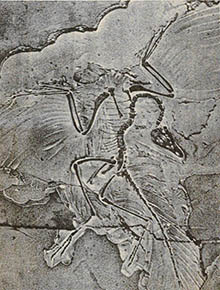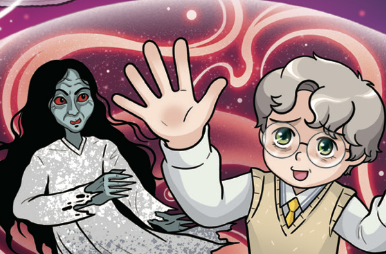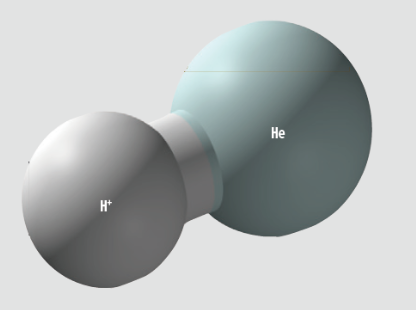
여태까지 발견된 화석중 가장 중요한 것이 가장 중요한 것이 가짜라고 한다면 그런 일이 있을 수 있을까? 몇몇 과학자들이 그런 주장을 펴고 있어 상당한 물의를 빚어냈다.
문제의 화석은 1861년에 발견되었는데 약 1억4천만년 전의 것이라고 추정되고 있다. 그것은 바위에 도마뱀과 매우 흡사하게 생긴 약 3피트 길이의 동물 한 마리가 선명하게 새겨진 것이다. 그것은 부리아닌 이빨이 나있는 머리와 긴 목과 긴 꼬리, 그리고 평평한 가슴뼈를 가지고 있어 모든 면에서 도마뱀과 비슷하다.
이 모든 점에서 이 동물이 오늘날의 도마뱀의 선조가 되는 지극히 오래 된 도마뱀이라고 연역해 내지 않고 있을까?
한가지 중요한 차이가 없었다면 그랬을지 모른다. 이 '도마뱀"은 깃털을 가졌던 것이다. 깃털의 흔적은 지금도 의심할 여지없이 생생히 남아있다. 깃털은 꼬리끝까지 두 줄로 나 있으며 또 앞발(날개)에도 나 있다.
오늘의 세계에서 알려진 모든 새는 깃털을 갖고 있으며, 또 새가 아닌 모든 생물에게는 그것이 없다. 따라서 이 화석은 대단히 오래 되고 원시적인 새의 잔해라고 생각된다. 이름은 '아키옵 터릭스'로서 그리스어로 '옛날의 날개'를 뜻한다.
아키옵터릭스는 오늘날 알려진 동물의 두 주요 집단 중간에 정확이 위치하는 것으로 보이는 가장 잘 알려진 생물형태의 화석이다. 그것은 반은 도마뱀이고 반은 새이며, 따라서 새로 진화해가는 과정에 있는 도마뱀의 완벽한 예이다.
기껏해야 원시적인 새였기 때문에 이 동물은 겨우 활강할 수 있었을 것이다. 아키옵터릭스에게는 아주 서투르게 나는것 이상은 불가능했을 것으로 보인다. 그렇다면 깃털이 처음 발생했을 때 날게 할 수가 없었다면 깃털의 의미는 무엇인가라는 의문이 자연이 나올 것이다. 분명히 쓸모없는 원시적 깃털이 단지 언젠가는 유용할 것이라는 이유만으로 진화했다고 가정하는 것은 이치에 닿지 않는다.
진화론자들의 이에 대한 답은 이렇다. 즉 설사 깃털이 새가 활강하는 것을 돕는데 불과했을지라도, 그 자체로 유용했을 것이며, 상황은 점차 개선돼 결국에 가서는 완전한 비행이 가능해지기에 이르렀다는 것이다. 실상 깃털은 우선 날기 위한 목적보다는 곤충을 잡는 일종의 '그물' 로서 진화되었을지 모른다. 깃털을 날기 위해서와 단열 장치로서 사용하게 된 것은 나중에 이차적 목적으로 발전되었을 것이다.
그러나 1985년 영국의 천문학자 '프레드호일'은 그의 두 조수와 함께 아키옵터릭스가 원시적 도마뱀애 불과하며, 화석이 처음 발견되었을 때 그 위에 시멘트를 덧씌우고 도마뱀-새의 인상을 남기기 위해 오늘날의 깃털을 시멘트에 꼽아넣었다고 주장했다.
아마도 이것은 과학자들을 골탕먹이려고 마음먹은 누군가에 의해 저질러졌다는 것이었다. (그런 장난은 전에도 있었다.) 아니면 어떤 열광적 진화론자가 진화론을 뒷받침할 증거를 만드는데 혈안이 되어 있었고, 또 자신이 올바른 대의라고 생각한 것을 위해서는 조작도 개의치 않았을지 모른다. 그렇지만 아키옵터릭스가 위조품이라 해도 이것이 생물학적 진화를 송두리째 무너뜨리지 못함은 물론이다. 진화의 진실은 어느 한 화석이 아니라 수많은 화석들, 그리고 더 많은 다른 것들에 의거하고 있다. 설사 화석이 존재하지 않는다 해도, 과학자들로 하여금 진화가 진정 사실이라고 확신시킬 충분한 물리학적 생리학적 생물화학적 그리고 해부학적 증거가 있다.
그럼에도 화석이 진화에 관한 가장 생생한 증거를 제공하며, 아키옵터릭스가 이런 종류의 증거 가운데서는 가장 훌륭한 것임은 부정할 수 없다.
과학자들은 대개 호일의 주장에 대해 증오와 경멸로 대응했으며, 호일은 아직껏 그들 가운데서 한명의 동조자도 얻지 못했다. (호일은 그밖에도 몇가지 인기없는 이론들을 만들어 냈는데, 이를테면 우주는 '빅뱅'(대폭발)에서 출발한 것이 아니다 끊임없는 창조를 통해 오늘의 모습을 이루고 있으며, 단순한 형태의 생명은 실제로 성간운과 혜성에서 형성된다는 내용이다. 따라서 많은 이들은 그를 심각하게 간주할 필요가 없는 일종의 이단자로 경멸해 버린다.)
아키옵터릭스의 화석을 가지고 있는 런던의 자연사박물관은 그것이 진품임을 확신하고 있으며, 뼈와 깃털이 동시에 바위에 자국을 남겼다는 것을 확실히 할 수 있는 미세한, 나아가 현미경적인 일치성이 존재함을 지적하고 있다. 호일은 현재 화석에서 암석의 조그만 조각을 얻어 시험해보길 원하고 있지만, 박물관측은 이를 용납치 않을 생각이며 그가 의도하는 시험이 어떻게 해도 아무것도 입증할 수 없을 것이라고 주장하고 있다.
나 자신은 호일의 주장에 공감하지 않는다. 한가지 내가 의심하는 것은 19세기의 위조범이 현대의 고생물학자를 속일 정도로 깃털자국을 잘 만들 수 있었을까 하는 점이다. (유명한 '필타운'의 위조범도 고생물학자들을 잠시동안만 속였을 뿐이다.) 보다 중요한 것은, 최소한 두개의 또다른 아키옵터릭스의 화석이 발견됐고, 이것들도 역시 첫번째 화석에서와 마차가지로 깃털이 나있다는 점이다.
세개의 똑같은 속임수일까? 그건 깃털달린 도마뱀보다 더 믿기 어려운 일이다.
Could it be that the most important fossil ever found is a fake? A few scientists claim it is and have created quite a stir.
The fossil in question was discovered in 1861, and is estimated to be about 140,000,000 years old. It is a clear impression, in a rock, of an animal about three feet long that looks very much like a lizard. It has a head possessing teeth and no beak, a long neck and a long tail, together with a flat breastbone-all very lizardlike.
From all this, why not deduce that the animal is an extremely ancient reptile, ancestral to the lizards of today?
That might have been the case, were it not for one all-important difference. The so-called "lizard" had feathers. The imprints of those feathers are present and are unmistakeable. The feathers are in a double row down the length of the tail, and are also present along the fore-limbs.
In the world today, every known bird has feathers, and all living things that are not birds do not have them, Therefore, this fossil is thought of as the remains of a very ancient and primitive bird. It is called " archeopteryx(ahr-kee-OP-tuh-riiks), from Greek words meaninng "ancient wing."
The archeopteryx is the best-known example of a fossil of a life-form that seems to fall exactly between two major groups of animals as recognized today. It is half reptile and half bird, annd therefore a perfect example of a reptile in the process of evolving into a bird.
It is such a primitive bird that, at best, it may only have been able to glide. Anything more than very weak flight would not seem possible for archeopteryx. Naturally, one might ask, what was the pointof feathers if, when they first developed, they did not make flight possile. Surely, it makes no sense to suppose that useless primitive feathers would evolve simply because they might somday be useful.
The answer evolutionists make is that even if they only helpled the bird glide, that in itself would be useful, and that the situation would slowly improve until full flight was possible. Indeed, feathers might not have evolved for the purpose of flight to begin with but as a sort of "net" with which to trap insects. Their use for flight and as an insulating device would develop as secondary purposes later.
The English astronomer Fred Hoyle, along with two associates, claimed in 1985, however, that archeopteryx was merely a primitive lizard and that once the fossil had been discovered, a layer of cemet had been placed over it and into that cement had been pressed modern feathers intended to leave the impression of a lizard-bird.
Presumably this had been done by someone merely intent on perpetrating an amusing hoax on scientists. (Such hoaxes have occurred before.) Or else some enthusiastic evolutionist was anxious to produce evidence in favor of evolution and didn't mind faking some for what he considerded a good cause.
However, even if archeopteryx was faked, this would not, of course, invalidate bilogical evolution. The truth of evolution rests not on any one fossil but on vast numbers of them, and on much more besides. Even if no fossils existed, there is enough physical, physiological, biochemical and anatomical evidence to convince scientists that evolution is indeed a fact.
Nevertheless, it can't be denied that fossils offer the most vivid testimony about evloution, and that archeopteryx is the most splendid single piece of this type of evidence.
Scientists, generally, have reacted to Hoyle's claim with anger and contempt, and Hoyle has, so far, made no converts among them. (Hoyle has also, originated several other unpopular theories, such as that the universe comes into being through continuous creation rather than through the Big Bang, and that simple forms of life actually form in cosmic clouds and in comets. Many, therefore, dismiss him as a sort of maverick who need not be taken seriously.)
the Natural History Museum in London, which possesses the archeopteryx fossil, is convinced of its authenticity and points out the existence of tiny, even microscopic correspondences that make it seem certain that bones and feathers both made their impression on the rock at the same time. Hoyle now wants to take a pinhead of rock from the fossil and subject it to tests, but the museum will not allow it and insists that Hoyle's intended tests would prove nothing one way or the other.
I myself am not impressed by Hoyle's claims. For one thing, I doubt that a 19th-Century hoaxer could have made the feathered impressions so well that they would fool modern paleontologists. (Even the famous Piltown hoax fooled paleontologists only temporarily). Much more important, at least tow other fossils of archeopteryx have been found and they, too, have feathers arranged as in the first fossil.
Three identical hoaxes? That's harder to believe than a reptile with feathers
















